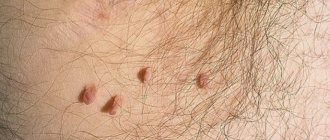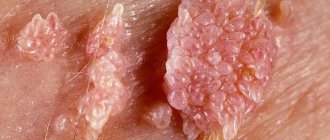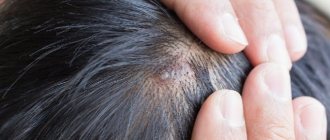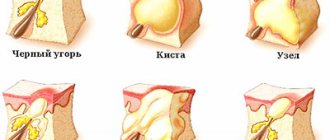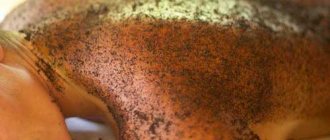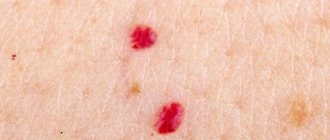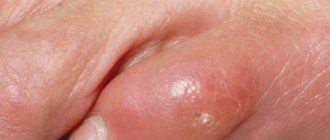Perianal condylomas are growths on the skin in the form of papillae, which are located in the anal folds and around the anus. They can be single or form large foci. Despite their apparent harmlessness, these tumors pose a danger to human health. Their appearance is caused by the activity of the human papillomavirus, and under certain conditions, condylomas can cause squamous cell carcinoma.
Of the 100,000 residents of St. Petersburg, 165 people are infected with HPV subtypes that provoke the formation of perianal condylomas.
How dangerous is the disease?
A person may not suspect for a long time that he is a carrier of papillomavirus. Since the first infection is carried out unnoticed, the virus, controlled by the immune system, does not make itself felt. The time period from penetration into the body to the formation of condyloma is from a couple of weeks to several years.
The virus enters the tissue and begins to actively develop. With an increase in the number of mature cells, it moves closer to the surface, resulting in growths. Being in this phase, a person is a carrier of the disease. Papillomavirus is transmitted through close contact with the skin of an infected person, and in rare cases through sexual contact. The pathology is dangerous because simple warts can develop into cancerous tumors with metastases to other organs.
Price
The cost of procedures for removing condylomas may vary; below is the approximate price in Moscow clinics for getting rid of anal formations:
- Laser removal will vary between 300-5000 rubles per piece, depending on the size of the tumor.
- A full course of anal wart removal will cost from 54,000 to 95,000 rubles.
Prices will depend on the size of the wart, its location, method of removal, etc.
Condylomas in the anus are an extremely unpleasant phenomenon, but removable. The main thing is to do everything in a timely manner. If the treatment is carried out correctly, the disease will no longer bother you. To prevent growths from appearing again, lead a healthy lifestyle and follow preventive measures.
Causes
With stable immunity, the disease does not develop, and the virus in the body is in an inactive form. The following factors can provoke its awakening, as well as further reproduction:
- Regular injury to the anal area.
- Presence of urogenital tract infections.
- Varicose veins of the small pelvis.
- Severe form of diabetes mellitus.
- Failure to comply with personal hygiene rules.
- Uncontrolled sexual intercourse.
Predisposing factors affect the state of not only the immune system, but also the entire body.
Symptoms of the disease
The following symptoms may indicate that a papilloma has appeared near the anus:
- burning;
- constant feeling of humidity;
- itching near the anus;
- pain during defecation;
- sensation of a foreign body in the rectum;
- mucous discharge from the anus.
Pathology is very rarely accompanied by elevated temperature, usually it rises to 37 degrees.
Appearance of the growth
Before talking about the symptoms of tumors around the anus, you should know all their types and forms.
Outwardly, they are similar to papillae and have an organic growth pattern. They can be either solitary or form a whole colony. Sometimes the growths merge into one large one and exceed more than 2 cm in diameter. A characteristic feature is the presence of a leg. Small bubbles grow and develop quickly. Especially if they are located on the mucous membranes of the skin. For them, this is the best place where it is warm and humid.
Condylomas can have different shapes. Here are the types:
Condylomas can have different shapes
- Pointed. Anal condylomas refer specifically to it.
- Papular.
- Horny.
- Flat.
Since the bubbles tend to grow next to each other, microbes often accumulate between them, which gives a disgusting smell, the top gets wet, which causes burning, redness, itching and frequent inflammation of the skin.
Diagnosis of condylomas
Before starting treatment for condyloma in the anus, you need to undergo a diagnostic examination, which consists of the following:
- The doctor examines the anus and rectum using a special device - an anoscope. Necessary to detect the causes of the inflammatory process and discomfort. If papillomas around the anus are observed in women, examination of the vaginal mucosa and cervix will be required.
- Thanks to the palpation method, the doctor specifies the location of the condyloma along the intestinal lumen. The growths are palpated as separate dense nodules united into numerous conglomerates.
- To determine the clear boundaries of the lesion, a specialist conducts a vinegar test. To do this, treat the anus area with a 3% acetic acid solution, after which the affected area turns gray. This procedure is necessary to take a biopsy, as well as before removing growths.
- If there is a suspicion of oncology, part of the scraping is sent for histological examination.
- At the end, the specialist takes a blood test for TORCH infection, and a smear to refute or confirm a sexually transmitted disease.
After diagnosis, the doctor prescribes further treatment for anal warts.
Complications of anal condylomatosis
The human papillomavirus is quite dangerous, since even with a single condyloma it can cause epithelial metaplasia.
This leads to one of the most dangerous complications of condylomas in the anus.
The risk of developing cancer depends greatly on the strain of the virus.
The HPV type is indicated by a number that characterizes a certain set of properties of the pathogenic microorganism.
The safest in terms of oncology are HPV types 6 or 11.
At the same time, much more often cancer can be induced by HPV strains numbered 16, 31 or 18.
Condylomas in men in the anus are more often caused by low-oncogenic strains, since HPV types 16 and 18 have an affinity for the epithelium of the female genitalia.
The presence of HPV in the uterus greatly increases the risk of cancer not only in the anal area, but also in the genital area itself.
Malignancy is one of the most dangerous complications of condylomatosis, but it is far from the only one.
The most common consequences of the formation of genital warts in the anus are discussed below.
- Bleeding. A frequent complication associated with arrosion of the vessel feeding the formation. Damage is possible through rough contact with easily injured condylomas. The situation is quite dangerous, since quite large vessels can be damaged.
- Suppuration. The lower the immune defense and worse the hygiene of a person, the higher the risk of bacterial infection. Condylomas in the anus during HIV infection are especially often susceptible to injury and suppuration, since the immunological status of the body is sharply disturbed. Due to the pronounced circulatory network of the pelvis, bacteria easily spread throughout the body, causing sepsis. Therefore, suppuration of condylomas is an extremely dangerous complication that threatens the patient’s life.
- Development of constipation and hemorrhoids. With condylomas, blood stagnates in the anal sphincter area. This leads to dilation of the veins and decreased peristalsis of the colon. As a result, hemorrhoids and habitual constipation develop quite quickly.
- Formation of giant Buschke's condyloma in the anus. A fairly rare complication, but one that causes serious problems for people. The essence of the painful situation is that several small condylomas merge with each other, forming a single inflammatory infiltrate. As a result, the traumatic surface increases, which creates conditions for rapid infection. Buschke's condyloma is a large formation, which is a conglomerate of several smaller pointed papillomas.
- Necrosis and bedsores of the skin around the anal ring. The problem arises with severe condylomatosis with large infiltrates that put pressure on the intergluteal region. As a result of malnutrition and infection, necrosis is formed, which leads to a sharp increase in pain. Deep necrosis is difficult to treat and often requires serious surgical interventions.
Condylomas in women and men in the anus are a serious pathology that requires prompt treatment.
The sooner radical measures are taken, the higher the chance of avoiding complications that affect a person’s quality of life.
How to treat condylomas
Before proceeding with the main treatment of papilloma around the anus and including taking various medications, it is necessary to eliminate the causes that provoke the progression of the viral disease. This applies to the rules of personal hygiene and sexual life.
The anal area where there are condylomas must be thoroughly washed with a bactericidal agent to prevent contamination. But water procedures should be performed carefully, without damaging the edges of the formations. During treatment, you should avoid anal sex, since trauma to the mucous membrane will provoke the progression of the disease.
Therapy includes not only taking medications and using special ointments, but also changing the usual way of daily and sexual life.
Main stages
- A healthy lifestyle, in order to strengthen the immune system and restore the body’s protective functions;
- use of antiviral drugs;
- undergoing immunomodulatory therapy;
- removal of condylomas through surgery;
The attending physician has the right to choose a treatment regimen, taking into account the results of all tests, as well as the characteristics of the course of the disease.
Treatment with antiviral agents alone can be carried out only at an early stage of development, when there are no complications and keratinized skin. But since the papillomavirus is very resistant to the action of such drugs, a large dosage of them is used in combination with local and systemic effects on the infection.
Drugs used to treat condylomas
- Interferon - used in the form of rectal suppositories and intramuscular infections.
- Glycyrrhizic acid is a gel for external use.
- Sodium deoxyribonucleate with iron is a powerful antiviral agent, used in a course for two weeks.
- Panavir is a herbal-based drug, prescribed locally or intravenously.
- Genferon is a combination drug that contains immune stimulants; has an analgesic effect. It is used topically in the form of rectal suppositories.
The article shows photos of what condyloma looks like.
Radical measures in the fight against papillomas
Despite the large number of therapeutic drugs that treat condylomas that resemble a tail in the anus, they cannot be cured with tablets and ointments alone. Moreover, with a high risk of developing a malignant tumor, prompt removal of condylomas is indicated.
The following methods are used for this:
- surgical removal;
- laser exposure;
- electrocoagulation;
- cauterization with liquid nitrogen;
- chemical destruction by active acids and alkalis;
- radiofrequency exposure.
When choosing a method, the symptoms are taken into account, as well as the form in which the disease occurs.
In case of severe irritation and painful discomfort, it is better to use more gentle removal methods, which include cauterization and radiofrequency exposure. It is better to remove large condylomas with a laser or using electrocoagulation to avoid bleeding. If oncology is suspected, any type of papillomas on the butt is subject to biopsy and surgically removed.
Treatment at home
The most important point when self-treating is not to damage healthy skin. To do this, you will need a person who will assist in the procedure. What to do? Buy a special adhesive tape impregnated with a medicinal composition at the pharmacy. Its action is aimed at destroying tumors. The instructions say that these tapes get rid of growth in 3-4 hours. The procedure may cause discomfort as the tape will press the papillomas against the skin. To minimize discomfort, it is recommended to moisten the infected area with cool water.
Many people ask the question: How to treat condylomas when it is not possible to buy pharmaceutical drugs, and why are such experiments dangerous? Treatment with folk remedies involves the use of potato juice, rosehip decoction, and plantain tincture. Moisten the skin in the affected area with any composition in the morning and evening.
- Celandine is also used to remove warts, growths or papillomas. It should be applied strictly to the condyloma itself. Lubricate the skin around the tumor with baby cream. It is better to ask a loved one for help, since given the location of the anal papilloma, it is unlikely that you will be able to perform the procedure yourself.
- Iodine has healing powers. Before manipulation, lubricate the skin around the papilloma with cosmetic oil. Apply the product directly to the growth itself. Perform 3 times a day. The method is also suitable if the child has papilloma on the bottom.
Conclusion
Even after the first removal of growths, patients will have to be monitored by a specialist throughout the year. Which doctor should a woman see? Representatives of the fairer sex need to undergo tests and visit a gynecologist, men will need an examination by a urologist.
Relapse and activation of the virus occurs due to provoking factors. To prevent this, you should avoid stressful situations, treat chronic diseases in a timely manner, get rid of bad habits, and not overload your body.
Preventive measures
After removal of condylomas, with proper nutrition and lifestyle, a person will not get sick or have obvious signs of HPV. But it is necessary to regularly visit a proctologist for examination and to identify possible recurrence of anal tumors.
It is imperative to follow certain rules that, firstly, will help avoid re-infection. And secondly, they will protect your partner:
- either abstain from sexual activity or use condoms with a high level of protection during intercourse;
- avoid constantly changing partners, have sexual relations with one person;
- exclude the use of alcoholic beverages and drugs;
- maintain hygiene, do not use other people’s things;
- maintain a daily routine, avoid stressful situations;
- follow a diet.

